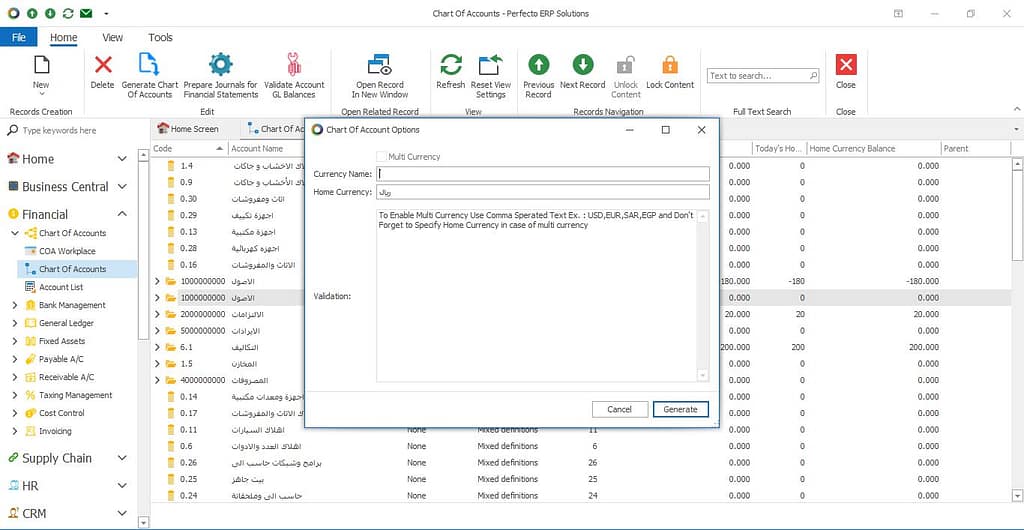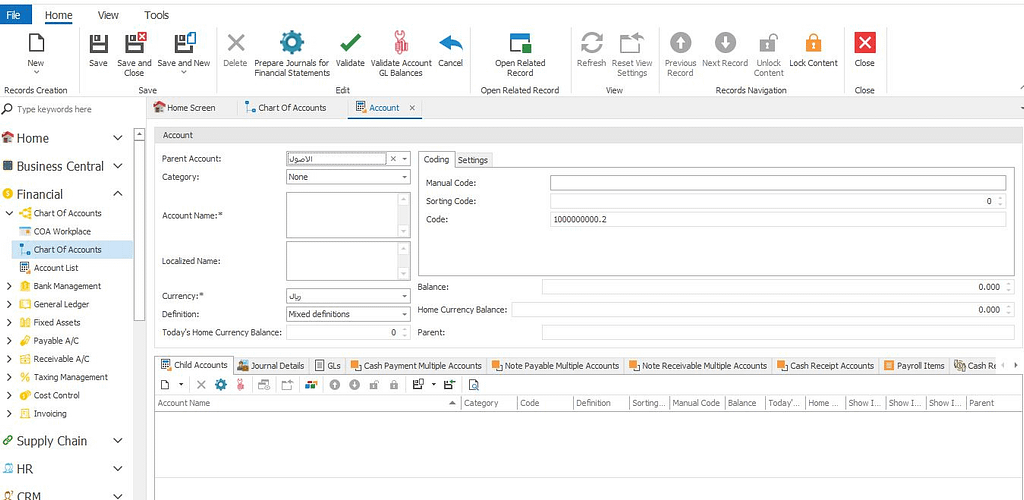The Chart of Accounts (COA) is the backbone of your financial system. It organizes all your financial transactions and ensures that your reports and dashboards are accurate and meaningful. This guide will help you set up your COA in a way that aligns with our system’s requirements, making it easier to generate reports and filter data.
The chart of accounts provides several benefits:
- Organization of accounts: It allows organizing financial accounts in a logical and hierarchical manner, which facilitates understanding the company’s financial structure.
- Preparing financial reports: By organizing accounts, a company can prepare financial reports easily and accurately, such as income, balance, and cash flow statements.
- Ease of searching and retrieving: The hierarchical organization of accounts makes it easy to search and retrieve financial data quickly when needed.
- Financial data analysis: The chart of accounts helps analyze financial data and discover patterns and trends, enabling accountants and financial managers to make better data-based decisions.
Perfecto ERP Solutions offers a comprehensive chart of accounts feature that equips users with several powerful tools to enhance their financial management capabilities. Key functionalities include:
- Multi-Level Account Creation: Users can create accounts at multiple levels, allowing for detailed and organized financial tracking. This hierarchical structure enables better categorization and management of financial data.
- Multi-Currency Support: Perfecto ERP supports the creation and management of accounts in more than one currency. This is particularly beneficial for businesses operating in multiple countries or dealing with international transactions, as it simplifies financial operations and reporting across different currencies.
- Unlimited Account Creation: There is no limit to the number of accounts that can be created. This flexibility ensures that businesses of all sizes and complexities can adequately map out their financial activities.
- Account Modification: Users have the ability to modify accounts as needed. This feature ensures that the chart of accounts can evolve with the business, accommodating changes in structure, strategy, or financial practices.
- Customizable Chart of Accounts: The system allows the design of a chart of accounts that fits the specific needs and formats used by the institution. This customization ensures that the financial reporting and accounting processes align perfectly with the organization’s standards and requirements.
These features collectively make Perfecto ERP Solutions a robust tool for managing a company’s financial framework, offering both flexibility and precision in financial tracking and reporting.
Here’s a step-by-step guide on creating a chart of accounts in Perfecto ERP Solutions, including setting up currencies and generating the chart:
- Accessing the Chart of Accounts Feature:
- Log in to your Perfecto ERP Solutions account.
- Navigate to the “Financial ” module.
- Locate and click on the “Chart of Accounts” section.
- Creating the Chart of Accounts:
- Click on the “Generate Chart of Accounts” button. This will open the chart of accounts creation interface.
- Setting Up Currencies:
- In the chart of accounts interface, find the “Currency Name” field.
- Enter the names of the currencies you deal with. For example, you might input “USD” for US Dollars, “EUR” for Euros, “GBP” for British Pounds, etc.
- Ensure that each currency you use in your transactions is listed correctly.
- Specifying the Home Currency:
- Identify the field for the home currency within the same interface.
- Write the name of your home currency in this field. For instance, if your base currency is US Dollars, you would enter “USD.”
- Generating the Chart of Accounts:
- After entering the necessary currency information, review the details to ensure accuracy.
- Click on the “Generate” button to create the chart of accounts. This action will compile your inputs and set up the accounts structure according to your specifications.
By following these steps, you will successfully create a detailed and customized chart of accounts in Perfecto ERP Solutions, tailored to the financial needs and currency requirements of your institution.

Here’s a detailed guide on creating a new account in Perfecto ERP Solutions:
- Accessing the Chart of Accounts Screen:
- Log in to your Perfecto ERP Solutions account.
- Navigate to the “Financial ” module.
- Go to the “Chart of Accounts” section.
- Creating a New Account:
- On the Chart of Accounts screen, look for a button labeled “New”
- Click on this button to open the new account creation form.
- Entering Account Details:
- Account Name: In the designated field, write the name of the new account. For example, “Office Supplies” or “Sales Revenue.”
- Category: Select the appropriate category for the account. This could be an asset, liability, equity, income, or expense, depending on the nature of the account.
- Parent Account: If this account is a sub-account of an existing account, select the parent account from the drop-down menu or list provided. If it is a top-level account, you can leave this field blank or select “None.”
- Saving the New Account:
- Once all the required details are filled in, you have a few options:
- Save: Click the “Save” button to save the new account and remain on the current screen.
- Save and Close: Click the “Save and Close” button to save the new account and return to the main Chart of Accounts screen.
- Save and New: Click the “Save and New” button if you wish to save the current account and immediately start creating another new account.
- Once all the required details are filled in, you have a few options:
By following these steps, you will be able to add new accounts to your chart of accounts in Perfecto ERP Solutions efficiently.

Understanding Account Definitions and Categories
Account Categories
The Account Category represents the broad classification of accounts in your ledger. Here are the main categories:
- Asset : Represents resources owned by the company, such as cash, inventory, or equipment.
- Liability : Represents obligations or debts the company owes, like loans or accounts payable.
- Expense : Represents costs incurred by the company, such as rent, salaries, and utilities.
- Revenue : Represents income generated from sales or services.
- Equity : Represents the owner’s interest in the company, such as capital or retained earnings.
- CostAccounting : Represents costs directly associated with the production of goods or services.
- OtherCreditors : Represents other liabilities owed to entities besides banks or suppliers.
- OtherDebitors : Represents other receivables owed to the company by entities besides customers
Account Definitions
Account Definitions provide a detailed description of each account, which is essential for accurate reporting and filtering. Here’s an overview of the available definitions:
- Mixed Definitions: Used for accounts that represent a combination of multiple financial elements or when specific classification isn’t required.
- Inventory: Represents goods and materials on hand, either for sale or for use in production.
- Receivable: Amounts owed to the company by customers, typically through sales made on credit.
- Prepaid Expense: Costs that have been paid in advance and are yet to be incurred, such as insurance premiums or rent.
- Fixed Asset: Long-term assets such as machinery, vehicles, or buildings that are used in the company’s operations.
- Investment: Financial assets purchased with the intention of generating income or appreciation.
- Cash and Cash Equivalent: Accounts like petty cash, bank accounts, or any liquid assets that can be quickly converted to cash.
- Intangible Asset: Non-physical assets such as patents, trademarks, or goodwill.
- Taxes: Represents obligations related to taxes owed or already paid by the company.
- Payable: Amounts the company owes to suppliers or creditors, such as accounts payable or accrued expenses.
- Interests: Represents interest expenses or income related to loans, savings, or other financial instruments.
- Accrued: Represents expenses that have been incurred but not yet paid, such as accrued wages or interest.
- Mortgage: Represents loans specifically tied to real estate assets.
- Operating Expenses: Day-to-day expenses required to run the company, such as rent, utilities, and office supplies.
- Non-Operating Expenses: Costs not directly related to the core operations of the company, such as interest expenses or losses from investments.
- COGS (Cost of Goods Sold): Direct costs associated with producing goods or services that the company sells.
- Shareholder’s Equity: Represents the owner’s interest in the company, including capital contributions and retained earnings.
- Retained Earnings: Profits that are kept in the company rather than distributed as dividends.
- Profit and Loss: Accounts used to track the company’s income and expenses over a period to determine profitability.
- Capital: Funds contributed by the company’s owners or shareholders.
- Stocks: Represents ownership in other companies, whether common or preferred stock.
- Goods Sales: Revenue generated from the sale of physical products.
- Service Sales: Income earned from providing services to customers.
- Rent: Income or expense related to renting property, whether it’s income from renting out space or expense from leasing it.
- Discount: Represents reductions in price given to customers, such as sales discounts or early payment discounts.
- Summary: Used for aggregated accounts that summarize the balances of other accounts.
- Cheques: Represents financial transactions involving cheques, including issued or received cheques.
- Custody: Accounts related to holding assets or funds on behalf of others.
- Loan: Represents borrowed funds that need to be repaid, whether short-term or long-term.
- Other: A general classification for accounts that do not fit neatly into other categories.
- Cost: Represents expenses directly tied to the cost of producing goods or services, similar to COGS but more granular.
- Non-Inventory: Accounts related to assets or costs not directly tied to inventory or production.
- Sales Return: Represents the return of sold goods, either due to customer returns or cancellations.
- Prepaid Liability: Represents payments received in advance for goods or services yet to be delivered.
- Investments Expenses: Costs associated with managing or acquiring investments.
- Sales and Marketing Expenses: Expenses related to promoting and selling products or services.
- Salaries: Represents payroll expenses for employees.
- Current: Represents assets or liabilities expected to be settled within one year, such as current liabilities or current assets.
- Non-Current: Represents assets or liabilities expected to be settled after more than one year, such as long-term investments or liabilities.
Examples of Chart Of Account Usage
Example 1: Cash Received from Customers
- Category: Asset
- Definition: CashAndCashEquivalent
- Usage: When customers pay their invoices, the cash received is recorded under an account defined as CashAndCashEquivalent.
Example 2: Payment of Salaries
- Category: Expense
- Definition: Salaries
- Usage: When paying employee wages, the expense is recorded under an account defined as Salaries.
Example 3: Inventory Purchase
- Category: Asset
- Definition: Inventory
- Usage: When purchasing goods for resale, the purchase is recorded under an account defined as Inventory.
Example 4: Setting Up Fixed Asset Accounts
When setting up accounts for each Fixed Asset, it’s important to create three distinct accounts to properly manage and report on the asset:
- Asset Account:
- Category: Asset
- Definition: Fixed Asset
- Purpose: This account represents the actual value of the fixed asset owned by the company.
- Liability Account:
- Category: Liability
- Definition: Fixed Asset
- Purpose: This account represents any liabilities associated with the fixed asset, such as a loan or mortgage used to finance the asset.
- Expense Account:
- Category: Expense
- Definition: Fixed Asset
- Purpose: This account tracks expenses related to the fixed asset, such as depreciation, maintenance, or repairs.
By structuring the accounts in this way, you ensure that the fixed asset is accurately represented in both the balance sheet and income statement, allowing for clear and precise financial reporting.
Key Takeaways
- Always select the correct Category and Definition for each account to ensure accurate reporting.
- Definitions are not just labels; they are used extensively in filtering data and generating reports.
- Properly categorizing and defining accounts will make your financial data more reliable and easier to analyze.
